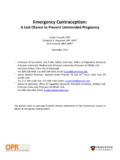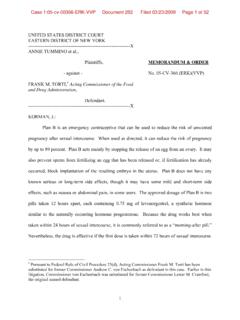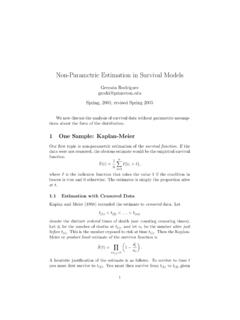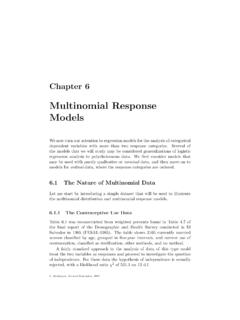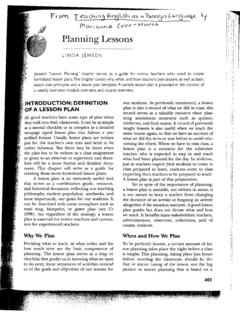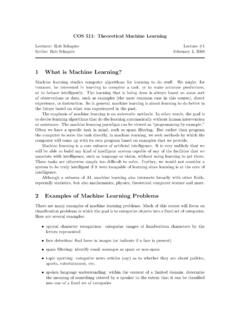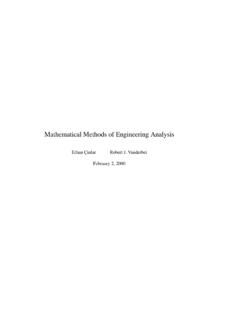Transcription of Emergency Contraception
1 Emergency Contraception : A Last Chance to Prevent Unintended Pregnancy James Trussell, PhD1. Elizabeth G. Raymond, MD, MPH2. Kelly Cleland, MPA, MPH3. November 2017. 1. Professor of Economics and Public Affairs, Emeritus, Office of Population Research, Princeton University, Wallace Hall, Princeton University, Princeton NJ 08544, USA. Honorary Fellow, University of Edinburgh Tel: 609-258-4946, Fax: 609-258-1039, Email: 2. Senior Medical Associate, Gynuity Health Projects. 15 East 26th Street, New York, NY. 10100, USA. Tel: 212-448-1230; Fax: 212-448-1260; Email: 3. Research Specialist, Office of Population Research, Princeton University, Wallace Hall, Princeton University, Princeton NJ 08544, USA. Tel: 609-258-1395; Email: The authors have no personal financial interest whatsoever in the commercial success or failure of Emergency Contraception .
2 Introduction About 45% of all pregnancies in the United States are unintended: million occurred in 2011 alone, the last year for which data are Emergency Contraception offers women a last chance to prevent pregnancy after unprotected intercourse. Emergency Contraception is especially important for outreach to the million women at risk of pregnancy but not using a regular method2 by providing a bridge to use of an ongoing contraceptive method. Although Emergency contraceptives do not protect against sexually transmitted infection, they do offer reassurance to the million women who rely on condoms for protection against pregnancy 2. in case of condom slippage or breakage. Emergency contraceptives available in the United States include Emergency contraceptive pills and the Copper T intrauterine contraceptive (IUC).
3 3-5 The levonorgestrel-releasing intrauterine system (sold as Mirena in the United States) is currently being studied for use as EC. Emergency contraceptive pills There are three types of ECPs: combined ECPs containing both estrogen and progestin, progestin-only ECPs, and ECPs containing an antiprogestin (either mifepristone or ulipristal acetate). All three are available in the United States. Progestin-only ECPs have now largely replaced the older combined ECPs because they are more effective and cause fewer side effects. Although this therapy is commonly known as the morning-after pill, the term is misleading; ECPs may be initiated sooner than the morning after immediately after unprotected intercourse or later for at least 120 hours after unprotected intercourse.
4 Combined ECPs contain the hormones estrogen and progestin. The hormones that have been studied extensively in clinical trials of ECPs are the estrogen ethinyl estradiol and the progestin levonorgestrel or norgestrel (which contains two isomers, only one of which levonorgestrel is bioactive). One combined, dedicated (meaning it was specially packaged for use as EC) EC product (Preven) was approved by the FDA in 1998 but withdrawn from the market in 2004. This combination of active ingredients used in this way is also sometimes called the Yuzpe method, after the Canadian physician who first described the regimen. When dedicated ECPs are not available, certain ordinary birth control pills can be used in specified combinations as Emergency Contraception .
5 In either case, the regimen is one dose followed by a second dose 12 hours later, where each dose consists of 4, 5, or 6 pills, depending on brand. Currently, 26 brands of combined oral contraceptives are approved in the United States for use as Emergency Contraception (see Table 1). Research has demonstrated the safety and efficacy of an alternative regimen containing ethinyl estradiol and the progestin norethindrone;6 this result suggests that oral contraceptive pills containing progestins other than levonorgestrel may also be used for Emergency Contraception . Progestin-only ECPs contain no estrogen. Only the progestin levonorgestrel has been studied for freestanding use as an Emergency contraceptive. The original treatment schedule was one mg dose within 72 hours after unprotected intercourse, and a second mg dose 12 hours after the first dose.
6 However, studies have shown that a single dose of mg is as effective as two mg doses 12 hours ,8 One of these studies showed no difference in side effects between the two regimens,7 while the other found greater levels of headache and breast tenderness (but not other side effects) among study participants taking mg of levonorgestrel at Increasingly, levonorgestrel is marketed internationally in a one-dose formulation (one mg pill) rather than the two-dose formulation (two mg tablets, taken 12 hours apart). (Another study found that two mg doses 24 hours apart were just as effective as two mg doses 12 hours ) The progestin-only products available in the United States include are Plan B One-Step ( mg), approved by the FDA in July 2009 (Table 1), and several generic forms of Plan B One-Step including Next Choice One Dose, My Way, Take Action and AfterPill; two-dose LNG EC pills are no longer sold in the US.
7 The second-generation antiprogestin ulipristal acetate (30 mg in a single dose) has been studied for use as Emergency Contraception and has been found to be highly effective and well- It has been marketed for use as Emergency Contraception in Europe since October 2009; it was approved by the FDA in August 2010 and is available for sale by prescription only, marketed under the brand name ella. Ulipristal acetate EC (sold as ellaOne) is available without prescription in Europe. The antiprogestin mifepristone has also been extensively studied for use as an Emergency contraceptive pill. Mifepristone is a first-generation progesterone receptor modulator that is approved for use in many countries for early first-trimester medication abortion.
8 Mifepristone has been shown to be highly effective for use as Emergency Contraception , with few side effects (delayed menstruation following the administration of mifepristone is one notable side effect.)14 However, the use of mifepristone as an abortion pill may limit its widespread acceptability for use for Emergency Contraception , and it is currently available only in Armenia, Moldova, Ukraine, China, Russia, and Vietnam. Meloxicam (a COX-2 inhibitor) 30 mg given for five consecutive days in the late follicular phase appears to be an effective Emergency contraceptive option. This regimen does not alter the endocrine profile of the cycle and causes no menstrual ,16 (In contrast, the COX-2 inhibitor celecoxib appears to have no potential for Emergency ).
9 Copper-bearing IUDs Implantation occurs 6-12 days following Therefore, copper IUDs can be inserted up to 5 days after ovulation to prevent pregnancy. Thus, if a woman had unprotected intercourse three days before ovulation occurred in that cycle, the IUD could prevent pregnancy if inserted up to 8 days after intercourse. Because of the difficulty in determining the day of ovulation, however, many protocols recommend insertion up to only 5 days after unprotected intercourse. The latest WHO guidelines allow IUDs to be inserted up to day 12 of the cycle with no restrictions and at any other time in the cycle if it is reasonably certain that she is not A copper IUD can also be left in place to provide effective ongoing Contraception for up to 12 But IUDs are not ideal for all women.
10 Women with active sexually transmitted infections (STIs) are not good candidates for IUDs; insertion of the IUD in these women can lead to pelvic infection, which can cause infertility if untreated. Women not exposed to STIs have little risk of pelvic infection following IUD insertion,21 and use of a copper IUD is not associated with an increased risk of tubal infertility among nulligravid women (whereas infection with chlamydia is).22. New research about levonorgestrel IUDs as Emergency Contraception is emerging. One study compared copper IUDs and oral levonorgestrel EC pills with concomitant placement of a levonorgestrel More women in this study chose oral LNG EC plus LNG IUD (121 women). over the copper IUD (67 women) at the time of their visit.
